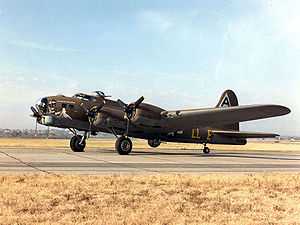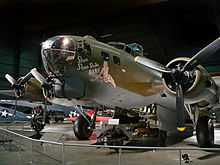Shoo Shoo Baby (aircraft)

"Shoo Shoo Baby" is the name of a B-17 Flying Fortress in World War II, preserved and on public display. A B-17G-35-BO, serial number 42-32076, and manufactured by Boeing, it was named by her crew for a song of the same name made popular by The Andrews Sisters, the favorite song of its crew chief T/Sgt. Hank Cordes.[1] Photographs of the bomber indicate that a third "Shoo" was added to the name at some point in May 1944 when the original aircraft commander completed his tour of duty and was replaced by another pilot.
The nose art on the airframe was one of some 130 pieces painted by line mechanic Tony Starcer for "The Ragged Irregulars", this one based on Alberto Vargas' "Hawaii" Esquire pin up art.[2]
Service history
The aircraft that would become "Shoo Shoo Baby" was accepted into the U.S. Army Air Forces inventory on 19 January 1944, and arrived in Great Britain on 2 March. After depot modifications, it was flown to the 91st Bomb Group at RAF Bassingbourn on 23 March and began flying missions the next day.[3] 2nd Lt. Paul C. McDuffee was the first pilot assigned to the aircraft and flew 14 of his 25 missions in it, but nine different crews flew Shoo Shoo Baby on missions.
The B-17 flew 24 combat missions from England with the 91st BG, with three other missions aborted for mechanical problems, before being listed as missing in action on 29 May 1944. On its final mission, to the Focke Wulf aircraft component factory at Poznań, Poland, it crash-landed at Malmö Airport, Sweden.
Final mission
The crew of "Shoo Shoo Baby" on the Poznań mission consisted of:
- 2nd Lt. Robert J. Gunther, pilot
- 2nd Lt. George Havrisik, co-pilot
- 2nd Lt. John M. Lowdermilk, navigator
- 2nd Lt. Leonard V. Peterson, bombardier
- T/Sgt. James Shoesmith, top turret gunner
- T/Sgt. John H. Bigham, radio operator/waist gunner
- S/Sgt. Nick Premenko, ball turret gunner
- S/Sgt. Harry J. Teems, tail gunner
- S/Sgt. Harold F. Nicely, waist gunner
This crew had been formed 26 April 1944, from replacements and had flown five previous missions together, all in aircraft other than "Shoo Shoo Baby".[4] The crew's navigator, 2nd Lt. John M. Lowdermilk, described the circumstances of Shoo Shoo Baby's final mission:[1]
“Soon after we crossed the German border, we lost number three engine, I believe because of losing oil pressure. Bob could not get the prop feathered (rotated 90° to put the blade edge perpendicular to the airflow). It continued to windmill (turn without power in the airflow) the entire trip with no vibration. We attempted to stay in formation with three engines but found this impossible and had to drop out. We continued on course to the best of my ability. We were losing altitude but continued to the target and dropped our bombs. Flying alone toward the Baltic Sea, we saw many German fighters attacking formations of B-17s and could not understand why they didn’t pick us out as a straggler. Before we reached the Baltic Sea, we lost the second engine, and the decision had to be made to go to Sweden because we could not make it back to England. Bob asked for a course to Sweden, and I charted one to a little town called Ystad in the very southernmost part of Sweden.
All loose equipment, including machine guns, radio equipment, and clothing, was thrown overboard in order to lighten the ship. An attempt was made to drop the ball turret, but it wouldn’t move.
As we approached the coastline, Bob was interested in knowing whether or not it was Sweden. I confidently stated that it was, but after the flak started coming up as we got over land, I wasn’t so sure. All of it was low, and I believe the Swedes were just telling us ‘Don’t try anything.’ Just before we reached land we lost the third engine, and we were losing altitude fast. A Swedish (J 9) fighter came up and led us to Malmö, Sweden, where a B-24, also in trouble, landed just ahead of us. Actually, we had to swing wide to keep from colliding."
European service
Sweden, a neutral country, interned the crew and aircraft, one of eight U.S. heavy bombers that diverted to Sweden that day. A deal was made between the Swedish and U.S. governments to permit around 300 American crewmen to be repatriated in exchange for a promise not to use the crewmen in combat again and to formally turn over to Sweden nine B-17s that had landed intact. Seven of these were converted by Saab Aircraft into airliners that could carry 14 passengers, and "Shoo Shoo Shoo Baby" flew for SILA (now Scandinavian Airlines).
In December 1945 it was one of two B-17s sold to Danish carrier Det Danske Luftfartselskab A/S, later a part of SAS, and remained in civilian service until June 1947 as the "Stig Viking" (civilian registry OY-DFA). The B-17 was subsequently transferred in March 1948 to the Danish Army Air Corps, flying as "Store Bjørn" 672, and in December 1949, to the Danish Naval Air Service. From October 1952 the Danish Air Force 721 Squadron used the transport for Greenland; finally retiring it a year later. After two years in storage, she was sold to the Institut Géographique National, a French aerial mapping company based in Creil outside Paris, and flew under the civilian registry F-BGSH[5]
Restoration and display

The aircraft was tracked down by Steve Birdsall, a noted military aviation historian from Australia. Last flown in July 1961, the remains of the plane were donated to the U.S. Air Force in 1972 when French officials presented the B-17 to Secretary of the Air Force Robert C. Seamans, Jr. for preservation. The journey from France required the assistance of the United States Air Forces in Europe to disassemble and crate the plane for truck shipment to Rhein-Main Air Base in Germany and then eventual airlift to the United States by C-5A transport.
Among those greeting the aircraft on its return were its wartime pilot Paul McDuffee, who had become an insurance salesman in Tampa, Florida, and retired USAF Major General Stanley T. Wray, the first commander of the 91st Bomb Group.[1]
A restoration was undertaken between 1978–1988 at Dover Air Force Base, Delaware by the 512th Military Airlift Wing in an effort that tallied some 60,000 man hours. In 1981, Tony Starcer recreated his original nose art at Dover Air Force Base, Delaware,[6] for the Fortress.[7] The aircraft was flown to Dayton on 13 October 1988, restored as "Shoo Shoo Shoo Baby".[8]
Put on display in place of long-time exhibit former-drone controller DB-17P, 44-83624, (a converted B-17G that did not see combat), which was subsequently sent to the Air Mobility Command Museum at Dover Air Force Base (sans its top turret, which it gave up for the restoration of "Shoo Shoo Baby") the reborn veteran can be seen today at the National Museum of the United States Air Force near Dayton, Ohio. The name has been restored to the original "Shoo Shoo Baby" and due to the amount of skin work required to restore its wartime appearance, it is finished in olive drab and grey instead of bare-metal as it was in operations.
Upcoming move
When restoration is completed of the National Museum of the United States Air Force's B-17D, "The Swoose", it will replace "Shoo Shoo Baby" as the museum's B-17 exhibit. At that time "Shoo Shoo Baby" will be transferred to the National Air and Space Museum's Steven F. Udvar-Hazy Center outside Washington, D.C. for permanent display. "The Swoose" will eventually be joined on display in Dayton by the B-17F "Memphis Belle" once restoration of that aircraft is completed. The decision to transfer "Shoo Shoo Baby" raised some concerns among the staff and patrons of the Dayton museum, as "Shoo Shoo Baby" is one of the world's finest restored examples of a B-17G, and has been a popular exhibit at the museum for many years. It was eventually pointed out that with the display of the "Swoose" and eventual display of the "Memphis Belle", the National Museum of the United States Air Force will possess the world's two most historically significant B-17s, and another B-17G model can easily be obtained when funds and space become available.
Notes
- ↑ 1.0 1.1 1.2 "The Return of Shoo-Shoo Baby". Air University Review, Jan-Feb 73. Retrieved 19 April 2007.
- ↑ http://nylon.net/pinups/vargas/x/vargas$hawaii.jpg
- ↑ Havelaar, Marion H. (1995) The Ragged Irregulars of Bassingbourn: The 91st Bombardment Group in World War II. Schiffer Military History. ISBN 0-88740-810-9
- ↑ "91st BG Dailies". 91st BG Association. Retrieved 2007-04-19.
- ↑ All information in this section from: "Boeing B-17G “Shoo Shoo Shoo Baby”". National Museum of the USAF. Retrieved 2007-01-09.
- ↑ http://www.usaaf-noseart.co.uk/starcer-tony.htm
- ↑ http://www.depot41.com/PartsInPlanes.htm
- ↑ Havelaar, p. 190
Sources
| Wikimedia Commons has media related to Shoo Shoo Shoo Baby. |
- Holder, William G. "The Return of Shoo-Shoo Baby" Air University Review
- Freeman, Roger A. with Osborne, David, The B-17 Flying Fortress Story, Arms & Armour Press, an imprint of the Cassell Group, London, WC2R 0BB, 1998, ISBN 1-85409-301-0.
- Thompson, Scott A., Final Cut - The Post-War B-17 Flying Fortress: The Survivors, Revised Edition, Pictorial Histories Publishing Company, Missoula, Montana, 2000, ISBN 1-57510-077-0.